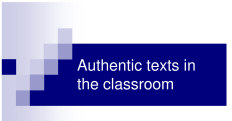Using Authentic Texts in Language Teaching
 Linguists have long been divided on whether to use simplified texts or
authentic texts in language classrooms. Given the features of both,
theories on their effectiveness are strongly in support with the claims.
For proponents of simplified texts, it is understanding that should go first,
not structures. For authentic text supporters, the distinct quality of a
language as used by the native speaker is what students ought to learn. Linguists have long been divided on whether to use simplified texts or
authentic texts in language classrooms. Given the features of both,
theories on their effectiveness are strongly in support with the claims.
For proponents of simplified texts, it is understanding that should go first,
not structures. For authentic text supporters, the distinct quality of a
language as used by the native speaker is what students ought to learn.
We always have to choose between the two sides of the coin. This can
also be applied in the decision of whether the teacher will or will not make use
of authentic texts in teaching language. Students learn important topics
through materials like audio, video, books, journals, magazines, newspapers and
online resources. It is a well-known fact that with reading and listening
learning is increased. Teachers make use of many strategies to foster
studentsí knowledge. Not too many students who learn a language will have
the chance to immerse with the people in the target language. One popular
strategy to simulate immersion into a different culture's language is to use
authentic texts in the classroom.
What is Authentic Text?
 It is generally defined as messages created, originally, to fulfill the
social purpose of the language in the community where it is used. With the
changing linguistic boundaries, it is now widely known as materials that include
ideas, words, phrases and expressions that are heard and read in real-life
situations. In simpler terms, these are materials that provide information
ready to be used as soon as the student leaves the classroom and starts to
mingle with others. It is generally defined as messages created, originally, to fulfill the
social purpose of the language in the community where it is used. With the
changing linguistic boundaries, it is now widely known as materials that include
ideas, words, phrases and expressions that are heard and read in real-life
situations. In simpler terms, these are materials that provide information
ready to be used as soon as the student leaves the classroom and starts to
mingle with others.
Authentic Texts Are Readily Available Everywhere
With the influx of language learners, it seems that the educators have to
utilize materials that are suited for their studentsí interests and proficiency
levels. One very good reason for teachers to consider using authentic texts is
its accessibility. It is quite easy to find and select important information for
students to learn from while surfing the internet, reading a newspaper, or while
having coffee. In most cases, it is easier to spot an interesting topic from the
mentioned material than it is from textbooks. This will become not only a source
of language conventions but of information on whatís going on around them.
The Benefits of Authentic Texts
Using authentic texts in the classroom are known to have the following
advantages:
 First, when authentic materials are made available for students, they provide
exact examples of how the language is used by its native speakers or of the vast
majority of target language users. This provides opportunities for class members
to get discourse exposures. There are a multitude of materials sold that claim
to be helpful in building decent foundations for language, but failed to provide
learners with up-to-date changes in target language usage. First, when authentic materials are made available for students, they provide
exact examples of how the language is used by its native speakers or of the vast
majority of target language users. This provides opportunities for class members
to get discourse exposures. There are a multitude of materials sold that claim
to be helpful in building decent foundations for language, but failed to provide
learners with up-to-date changes in target language usage.
Second, students feel more confident using the language when they know they
are performing as expected. With authentic texts, learners are provided with
words and expressions used in real-life contexts. When students are confronted
with similar situations, they are less likely to shy away from the need to
communicate.
Third, materials that are published weekly are more informal and
socially-centered than those that purely define rules and provide patterns for
sentences. Additionally, articles from magazines make use of expressions that
may not always be acceptable for prescriptive linguists but are widely used in
informal, face-to-face communications.
Lastly, authentic materials include new features of the language that would
take some time to get adapted in textbooks. With this, it keeps teachers and
students aware of changes in language. When craze words and phrases are
introduced, students are likely to be interested about how they are used. As
opportunities arise, they can understand and give opinions on issues using these
words.
Answer to Dynamic Linguistic Changes
 Language is dynamic. It changes with demands of society migrations, popular
culture, and even technological innovations. If teachers rely on traditional
textbook for materials for class, teachers will be constantly providing outdated
information. Students trained to use the language as the native speakers do will
find less need to alter their language later when using it conversationally. In
addition, when given the opportunity to travel to places where the target
language is used, the learner will not have as much difficulty understanding
announcements such as safety measure in airlines, or conversation in schools
they wish to attend. Language is dynamic. It changes with demands of society migrations, popular
culture, and even technological innovations. If teachers rely on traditional
textbook for materials for class, teachers will be constantly providing outdated
information. Students trained to use the language as the native speakers do will
find less need to alter their language later when using it conversationally. In
addition, when given the opportunity to travel to places where the target
language is used, the learner will not have as much difficulty understanding
announcements such as safety measure in airlines, or conversation in schools
they wish to attend.
Research revealed that communications in English are mostly between a native
and a non-native. Using authentic texts may be difficult as claimed by
proponents of simplified texts, but it provides students with practice and
increases their ability to communicate in a variety of contexts and issues.
Languages
Blogging as a Pedagogical Tool in ESL/EFL Writing Classes
ESL Classroom Strategies That Compel Students to Communicate
Top 10 Ways to Improve English Skills Without Spending Much
The Benefits of Language Exchange Partnerships
How to Help Students Become Self-Directed
How to Teach ESL Students Writing
How Can a Non-Native Teacher Instruct in English
Top Five Reasons Students Commit the Same Grammar Mistakes
Boosting ESL Studentsí Confidence in Speaking
Using Authentic Texts in Language Teaching
Teachers as Facilitators in Language Classrooms
The Benefits of Learning English Free on the Internet |